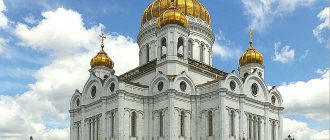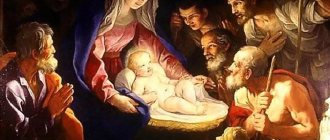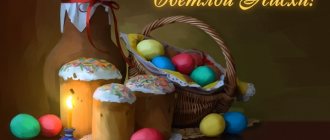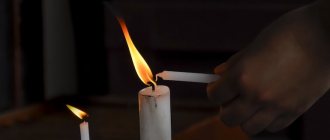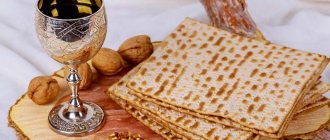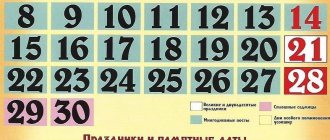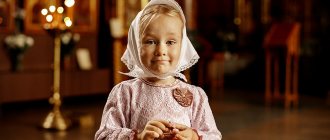Easter in paintings by Russian artists
The unforgettable moments of the All-Night Liturgy are still fresh in my memory: the procession, the rejoicing: “Christ is Risen!” and communion, the enlightened faces of the parishioners. Once again, mentally returning to this event, you involuntarily think that the essential, deep understanding of Easter is common, the same for everyone - Christ has risen, death has been defeated, hope has returned to this world again, the course of history has changed.
Descent into Hell..According to the original by M. V. Nesterov. Mosaic of the Church of the Resurrection of Christ (Savior on Spilled Blood), St. Petersburg from here
Descent into hell. Nikolai Andreevich Koshelev. 1900 200x350. Passion cycle of painting of the Church of St. Alexander Nevsky, Alexander Metochion of the Imperial Orthodox Palestine Society, Jerusalem
Christ risen. K. P. Bryullov. 1840s Canvas, oil. 177 x 89. Sketch for the Cathedral of Christ the Savior in Moscow. The plan was not realized. State Russian Museum, St. Petersburg
Nesterov
Resurrection (Resurrection Morning). Triptych. 1908-1909. Sketch for the painting of the southern wall of the Church of the Intercession of the Virgin Mary
Surprisingly, it was not His closest disciples who first learned about the Resurrection of Christ, but the very women who saw His death on the Cross. The day after the Sabbath, Mary Magdalene, Mary, the mother of James and Salome went to the tomb in which they laid the Teacher with myrrh (fragrant oil) to anoint his body - this was the Jewish funeral custom. That is why they are called that way - the Myrrh-Bearing Wives.
But, approaching the tomb, they saw that the stone that covered the entrance to it had been rolled away and was lying nearby. And when they entered the cave, the women did not find the body of Christ there. When they were perplexed about this, two men suddenly appeared before them in shining clothes. And when they were in fear and bowed their faces to the ground, they said to them: Why are you looking for the living among the dead? He is not here: He has risen; remember how He spoke to you while He was still in Galilee, saying that the Son of Man must be delivered into the hands of sinful men, and be crucified, and on the third day rise again. And they remembered His words; and returning from the tomb, they proclaimed all this to the eleven and to all the rest (Lk 24:4–9).
Mikhail Nesterov’s triptych “Morning of the Resurrection,” which is kept in the Tretyakov Gallery, depicts a conversation between the Myrrh-Bearing Women and an angel and the appearance of the risen Christ to Mary Magdalene.
1
Mary, mother of Jacob. According to the story of the Evangelist Mark, the Myrrh-Bearing Wives, going to the tomb, discussed who could roll away the heavy stone from the entrance to the cave. But it turned out that the stone had already been rolled away. And entering the tomb, they saw a young man sitting on the right side, dressed in white clothing; and they were horrified (Mark 16:5-8).
Vintage Easter cards printed for Russia
Dear friends! In this publication I would like to continue the topic of creating vintage cards, which I started in my previous publication: Foreign vintage Easter cards
. This time I will talk about postcards issued for Easter in our country and especially for Russia abroad more than a hundred years ago. For Easter 1898, the Community of St. Eugenie produced the first artistic illustrated cards. From this time on, the life of the national greeting card and the publishing activity of the community began, which later became the largest publisher of postcards on all topics. In the same year, postcards with subjects allowing you to congratulate Easter, Merry Christmas, and Happy New Year were published by such artists as Elizaveta Bem, M. Willie, V. Ovsyannikova, S. Solomko, etc. All of them were made with chromolithography and the quality and beauty were superior to many European samples. The postcard featured artists with extensive experience in book and magazine graphics. N. Karazin brought into fashion troikas flying in a snowstorm, hawthorn with pies, and scenes from village life. Elizaveta Bem created postcards with village children and proverb signatures, but did not illustrate the proverb, but, on the contrary, paraphrased the proverbs to suit her subjects. Following her, a whole galaxy of less skilled artists appeared, but devoted to this topic: E. Lebedeva-Anokhina, V. Lebedev, V. Taburin, S. Verov.
The Russian theme has become the main one in Russian illustrated postcards. From the first congratulatory scenes, N. Karazin and E.M. Bem created a visual and moral orientation in the Russian theme, where the image unusually accurately reflects the clothing and life of the population of the village and urban outskirts, and historical scenes, if embellished, are fully consistent with the mass perception of the time .
In the 1910s, the circle of Russian postcard publishers expanded, but most of them were chasing easy money and large circulations, using thin, low-quality paper, cramped lithographic machines for the first editions and cheap color autotypes for subsequent reprints. Almost everyone exploits the Russian theme, rarely mentioning the name of the artist.
There were not enough Russian products. The specifics of Russian censorship forced merchants to order greeting cards in Germany and France, and publishers to open publishing houses with mixed capital in Stockholm and the Russian publishing house of I. Lapin in Paris. And Lapin printed postcards using chromolithography with gold and gold edges and color autotype; Stockholm publishers preferred color autotype. European quality in terms of image richness and clarity exceeded the capabilities of most Russian printing houses. Since the end of the 19th century, the domestic market has been colorful with European greeting cards with subjects that are alien to us, but attractive in image.
Postcards were an expensive pleasure. Chromolithographs and three-color autotypes were sold for 10 kopecks apiece, phototypes for 5 kopecks. There were postcards of lower quality for 1 kopeck.
And suddenly everything came to an end. The peace with Germany ended - and with it the “bromo-silver”, “plush”, “real engravings with a gold edge” ended. The history of postcards in Russia was interrupted for many years.
After 1914, at least postcards were printed in Russia. But after the 1917 revolution, the production of greeting cards in Russia ceased. Finally. Because postcards (like many other things) are a sign of bourgeois society and the proletariat does not need them. And Christmas and Easter were not officially celebrated. But people still continued to congratulate each other. The most thrifty ones used old, pre-revolutionary postcards for this.
To make it more pleasant for you to admire these old postcards, I have improved their quality in a graphic editor - contrast, brightness, clarity.
Easter drawing for children, step by step
Option No. 1. Try drawing an Easter cake with your child for Easter. This is quite easy to do. The drawing presented to your attention shows step by step the process of drawing Easter cake and eggs on a plate. You can color it as you wish.
Option number 2. Drawing an Easter bunny for Easter would also be a good idea. In the picture below we have depicted in detail the sequence of drawing the parts of a hare with an egg. As you can see, drawing such a picture is not at all difficult.
Easter eggs children, with photo
Option No. 1. Eggs can be painted with ordinary watercolors or gouache, or you can use a pencil.
You are allowed to draw anything. These can be flowers, berries, houses, etc. Option No. 2. In addition to watercolor paints and gouache, you can also use adhesive paper to decorate Easter eggs, from which you can cut out all sorts of figures. The picture below shows an example of such egg decoration. Option number 3. Beautiful Easter eggs can be painted with food coloring, you can make original stands for them in the form of costumes, cool hats and make eyes. Then draw a mouth with a felt-tip pen or pencil and you will get funny little people, like in the picture below.
Easter kids video
We have provided you with a couple of videos. They tell about Easter in a simple and clear way, so children will quickly understand the essence of this holiday.
Show this video to your children on the eve of Easter, and after that it will be easier for you to explain to the kids what this day means.
Now you know how to tell your children about Easter. May grace and peace come to your home along with the holy holiday of Easter, may your family not know sorrows and sorrows!
Easter Poems for Children
Option number 1 .
You can suggest teaching this poem to children in the middle group of kindergarten; it is easy to remember. Option number 2. The next Easter poem is very simple, so even a 2-3 year old child can easily remember it.
Option No. 3. This verse is more difficult, it is better to entrust it to older children.
Option number 4 . This version of the Easter rhyme is simple and this means that the youngest children who already know how to speak will be able to learn it without any problems.
Option number 5 . Middle-aged children will understand this rhyme and learn it quickly. Invite them to read it on Easter.
